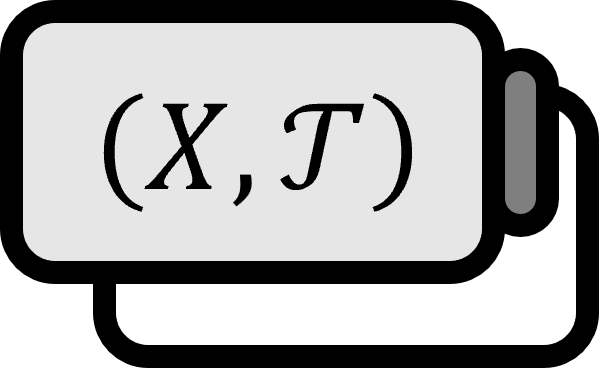Several Equivalent Conditions for the Interior in a Topological Space
Definition 1
Let us consider a topological space $(X,\mathcal{T})$ and a subspace $A$. The union of all open sets contained in $A$ is called the interior of $A$, denoted by $A^{\circ}$ or $\mathrm{int}(A)$. $$ A^{\circ} = \cup \left\{ U \in \mathcal{T} \ :\ U \subset A\right\} $$ Furthermore, if there exists an open set $U$ satisfying $x \in U \subset A$ with respect to $x \in X$, then $x$ is called an interior point of $A$, denoted by $x \in A^{\circ}$.
Explanation
Considering the definition of the interior, the definition of interior points is quite natural. By the definition of topology, the union of open sets is an open set, so $A^{\circ }$ is the largest open set contained within $A$.
Example
Suppose we have the set $X=\left\{ a,b,c,d\right\}$ with the topology $$ \mathcal{T}=\left\{ \varnothing, \left\{ a \right\}, \left\{a,b\right\}, \left\{c,d\right\}, \left\{ a,c,d\right\}, X \right\} $$ and the subset $A= \left\{ a,b,c \right\}$. To determine whether $a,b,c,d$ are interior points of $A$,$(1)$ since $a\in \left\{a \right\} \subset A$, $a\in A^{\circ}$.$(2)$ since $b \in \left\{ a,b\right\} \subset A$, $b \in A^{\circ}$.$(3)$ although $c \in A$, because of $c \in \left\{ c,d\right\} \not \subset A$, $c \in \left\{ a,c,d\right\} \not \subset A$, $c$ is not an interior point. $c \notin A^{\circ}$.$(4)$ since $d \notin A$, it is not an interior point. $d \notin A^{\circ}$.$A^{\circ}$ can also be determined by utilizing it being the largest open set contained within $A$. $$ A^{\circ}=\left\{ a,b\right\} $$
Theorems
- [1]: For a subset $A$ of a topological space $(X,\mathcal{T})$, the following three conditions are equivalent.
- $(a1)$ $A$ is an open set.
- $(b1)$ $A=A^{\circ }$
- $(c1)$ Every point of $A$ is an interior point of $A$. In other words, for all $x \in A$, there exists an open set $U_{x}$ satisfying $x \in U_{x} \subset A$.
- [2]: Given a basis $\mathcal{B}$ and a subset $A \subset X$ of a topological space $(X,\mathcal{T} )$, the following two conditions are equivalent.
- $(a2)$ $x\in A^{\circ}$.
- $(b2)$ There exists a $B \in \mathcal{B}$ that satisfies $x\in B \subset A$.
For metric spaces, it can be represented as follows.
- [3]: Given a metric space $(X,d)$ and a subset $A \subset X$, the following two conditions are equivalent.
- $(a3)$ $x \in A^{\circ}$.
- $(b3)$ There exists a $r>0$ satisfying $B_{d}(x,r)\subset A$.
- $B_{d}(x,r)$ represents an open ball in the metric space $(X,d)$ with center $x$ and radius $r$.
Proofs
[1]
$(a1) \implies (b1)$
Since $A^{\circ}$ is the largest open set contained within $A$, if $A$ is an open set, then $A=A^{\circ }$
$(b1) \implies (c1)$
This is self-evident.
$(c1) \implies (a1)$
Since $A=\bigcup \nolimits_{x\in A}U_{x}$ and the union of open sets is an open set, $A$ is an open set.
■
[2]
$(a2) \implies (b2)$
By the definition of interior points, there exists an open set $U\in \mathcal{T}$ satisfying $x\in U \subset A$. Also, by the definition of a basis, there exists a $B \in \mathcal{B}$ satisfying $x \in B \subset U$. Therefore, $x\in B \subset A$ is satisfied.
$(b2) \implies (a2)$
Since $\mathcal{B} \in \mathcal{T}$, $B$ is an open set containing $x$ as an element. Thus, $x$ is an interior point.
■
[3]
The basis and topology of the metric space $(X,d)$ are given as follows. $$ \mathcal{B}_{d}=\left\{B_{d}(x,r)\ :\ x\in X,\ 0<r \in \mathbb{R} \right\} $$ $$ \mathcal{T}_{d}=\left\{ U\subset X\ :\ \forall x\in U,\ \exists r_{x}>0 \ \text{s.t.}\ x\in B_{d}(x,r_{x})\subset U\right\} $$ Therefore, it holds by Theorem 2.
■
Munkres. (2000). Topology(2nd Edition): p95. ↩︎
